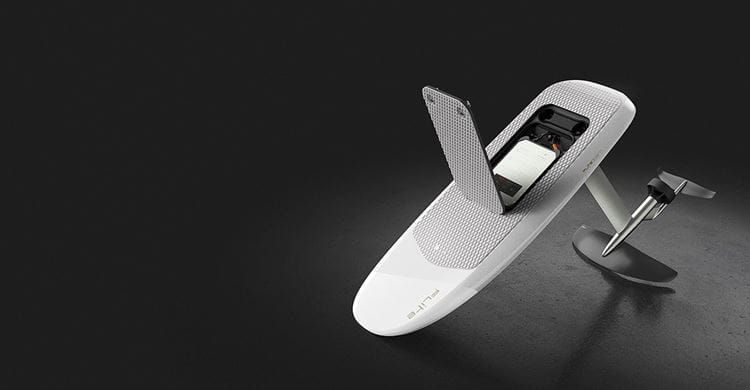Nordic Semiconductor today announces that Tekt Industries, a Melbourne, Australia-based technology company, has selected Nordic’s nRF52832 Bluetooth® Low Energy (Bluetooth LE) System-on-Chip (SoC) to provide the wireless connectivity for its client’s ‘Fliteboard’ system.
The Fliteboard is a remote-controlled electric board allowing watersport enthusiasts to ‘surf’ on any body of water with a depth of at least one meter up to speeds of 45km/h. The Fliteboard system comprises a 6kW brushless electric motor-powered hydrofoil (‘eFoil’) board, as well as the ‘Flite Controller’ remote handset. Both the board and the handset integrate a Rigado ‘BMD-350’ Bluetooth LE module based on Nordic’s nRF52832 SoC.
The handset relays control data to the board via Nordic SoC-enabled low latency Bluetooth LE connectivity, enabling the rider to wirelessly control the speed of the motor, even when the devices are submerged in water. Bidirectional Bluetooth LE connectivity also allows the handset to receive key data from the board itself—such as telemetry and battery status—then display the information on the integrated screen.
The board’s fully sealed subassembly, including the integrated Nordic SoC-based module, is embedded directly into the carbon fiber shell and provides GPS data recording, motion measurement, telemetry transport, and data transfer hardwired to the main eFoil module. As well as connecting the board to the handset, the Bluetooth LE link enables the board to communicate with the accompanying iOS-compatible ‘Flite App’ on the user’s Bluetooth 4.0 (and later) smartphone. The companion app can be used to download session data and provide a visual representation of the session using a map view and various icons including tilt and roll angles, speed, and battery status. The rider can also use the app to share the rides and upload the content to the Cloud.
Nordic’s nRF52832 multiprotocol SoC combines a powerful 64MHz, 32-bit Arm® Cortex® M4 processor with floating point unit (FPU), with a 2.4GHz multiprotocol radio (supporting Bluetooth 5.2, ANT™, and proprietary 2.4GHz RF protocol software) featuring -96-dB RX sensitivity, with 512kB Flash memory and 64kB RAM. The SoC is supplied with Nordic’s S132 SoftDevice, a Bluetooth 5.2-certifed RF software protocol stack for building advanced Bluetooth LE applications. The S132 SoftDevice features Central, Peripheral, Broadcaster and Observer Bluetooth LE roles, supports up to twenty connections, and enables concurrent role operation. Nordic’s software architecture also includes a clear separation between the RF protocol software and Tekt Industries’ application code, simplifying development and ensuring the SoftDevice doesn’t get corrupted when developing, compiling, testing, and verifying the application code.
The proprietary IP67-rated Flite Controller handheld device employs a 500mAh Li-Poly battery providing approximately one week of regular use before recharge—an important rider safety feature—thanks in part to the ultra low power characteristics of the Nordic SoC. The nRF52832 has been engineered to minimize power consumption with features such as the 2.4GHz radio’s 5.5mA peak RX/TX currents and a fully-automatic power management system that reduces power consumption by up to 80 percent compared with Nordic’s nRF51 Series SoCs. The board itself employs a custom high-capacity battery management system that provides riding time for up to 30km before recharge.
“The nRF52832 SoC’s Arm Cortex M4 processor with FPU provided powerful processing capability and radio sensitivity for the Fliteboard system, while using the same Nordic chipset with multipurpose, retaskable GPIOs [general-purpose input/outputs] in both the board and the handset enabled more agile development, thus accelerating our time to market,” says Matthew Adams, CEO of Tekt Industries. “Crucially, optimization of the power management for the Flite Controller unit’s active, idle, and power-off states was achieved through the Nordic SoC’s low power consumption.
“Nordic’s software frameworks were also well documented, easy to use, and adaptable. The SoC’s safe OTA-DFU [over-the-air device firmware update] functionality is a fantastic feature for long-term product support and easy upgrades.
“As a company, Nordic has a global reputation for developing robust products which come with a wide range of application examples, reference designs, and software development kits [SDKs]. In our experience Nordic provides great technical support with fast response times compared to its competitors.”

